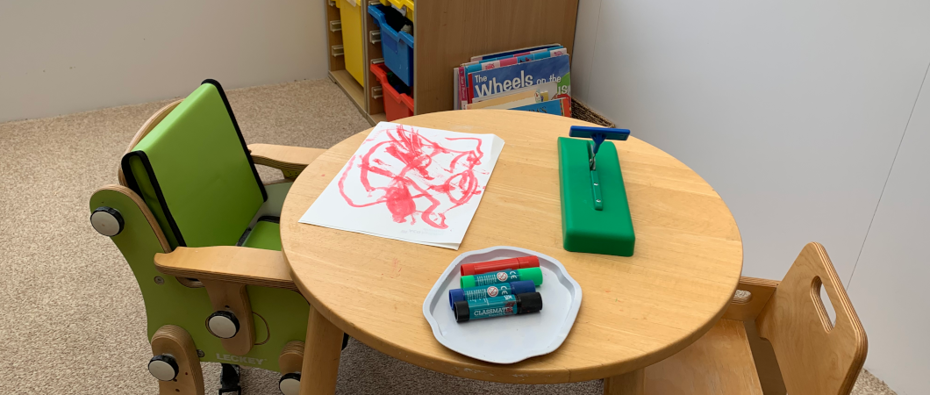Page Contents

Enabling Environment
Within the Early Years, the language and communication pyramid is often used to show the key elements of speech, language and communication and visually show the foundations upon which speech, language, and communication are built.

- Follow the child’s lead or imitate the child (intensive interaction).
- Observe carefully, to respond to children’s communication attempts (remember to be an OWL- Observe Wait Listen).
- Use visuals to support communication (photos, symbols, props).
- People games e.g., peek a boo support shared attention and communication.
- Action songs.
- Anticipation activities to prompt communication e.g., Ready Steady Go activities.
- Give choices in motivating and meaningful situations e.g., holding up two objects.
- Support a child to access and use augmentative and alternative communication e.g., Makaton, communication books, etc. (in collaboration with parents or carers and relevant involved professionals).
- Use songs and sensory stories to build in anticipation and opportunities to engage and communicate.
- Joint attention bucket and extension activities.
- Activities to support joint attention.
- Listening activities or sound discrimination activities.
- Small group activities to support attention and listening.
- Reduce background noise and distractions.
- Activities 1:1 or in smaller groups in a distraction-free environment.
- Stop-and-go games.
- Action songs and rhymes.
- Stories with a repetitive refrain.
- People games.
- Modelling and imitating play.
- Model playful language and sounds in play.
- Create playful opportunities in play for the child to initiate and communicate e.g., pausing in a fun interaction such as bouncing on a ball.
- Comment on play with simple and predictable sounds, and words.
- Turn-taking games.
- Use simple repetitive language in play, songs, and routines, including group times to provide a model appropriate for children to imitate.
- Identiplay.
- Support language with visuals, appropriate to the child’s needs this may be objects, photos, symbols.
- Use consistent gestures and singing to support language.
- Reduce language (be aware of the child’s level of understanding and pitch language appropriate to this).
- Instructions should be appropriate to the child’s understanding e.g., how many information-carrying words they can process, breaking down instructions where needed and given in the appropriate order.
- Reduce questions, focussing on commenting.
- Allow the child time to process instructions (ten seconds).
- Give choices appropriate to the child’s developmental level with appropriate visual support
- Actively use visual supports e.g., Visual timetables or choice boards.
- Activities to support listening.
- Use simple repetitive language in play, songs, and routines, including group times.
- Ensure you have the child’s attention before communicating with them (say the child’s name but you may need to wait for a response and or go close to the child and get down to their level).
- Simple social stories to support spoken language to explain an event or activities.
- Consider children’s ability to understand group instructions and provide the appropriate support to do so e.g., individual instruction and visuals.
- Consider children’s access to group times which often has a significant reliance on the child’s attention and listening skills and their understanding of language.
- Model keywords.
- Talking Tennis.
- Use visuals to support communication (photos, symbols, props).
- Support the child to communicate in situations and about things that are motivating and meaningful for them.
- Prompt communication e.g., Ready Steady Go activities.
- Use stories to develop language (and dialogic reading).
- The use of choosing boards to support child communication choice.
- Reduce choices appropriate to the child’s developmental level and support with appropriate visuals.
- Support a child to access and use augmentative and alternative communication e.g., Makaton, communication books, PECS etc. (in collaboration with parents or carers and relevant involved professionals).
- Model back language, rather than correct incorrect attempts.
- Add one word to the child’s speech when modelling back?
- Listening or sound discrimination activities.
- Reduce language (be aware of the child’s level of understanding and pitch language appropriate to this).
- Comment on play with simple and predictable sounds, and words. Use simple repetitive language in play, songs, and routines, including group times to provide an appropriate model for children to imitate.
- Choose songs and stories that have a simple, fun, and predictable refrain to join in with.
- Small group activities to support speech and language skills.
- Access to a supportive, language-rich, and inclusive learning environment, which reinforces the development of language and communication through verbal and non-verbal means.
- All members of staff model appropriate language and communication.
- Practitioners are aware of appropriate strategies, support individual children’s needs, and consistently implement these.
- Practitioners understand or seek support to ensure effective support is in a place where a child uses an augmentative or alternative communication system e.g., Makaton.
- There is a whole-setting commitment to accessing and engaging in SLCN training.
- Visual supports such as visual timetables are accessible and used consistently for whole groups and individual supports are considered and consistently implemented by all staff where there is a need.
- There is consistency across strategies and visual support systems used throughout the setting, which may be adapted for individual children to meet their needs.
- There is a ‘communication friendly’ approach across the whole setting.

